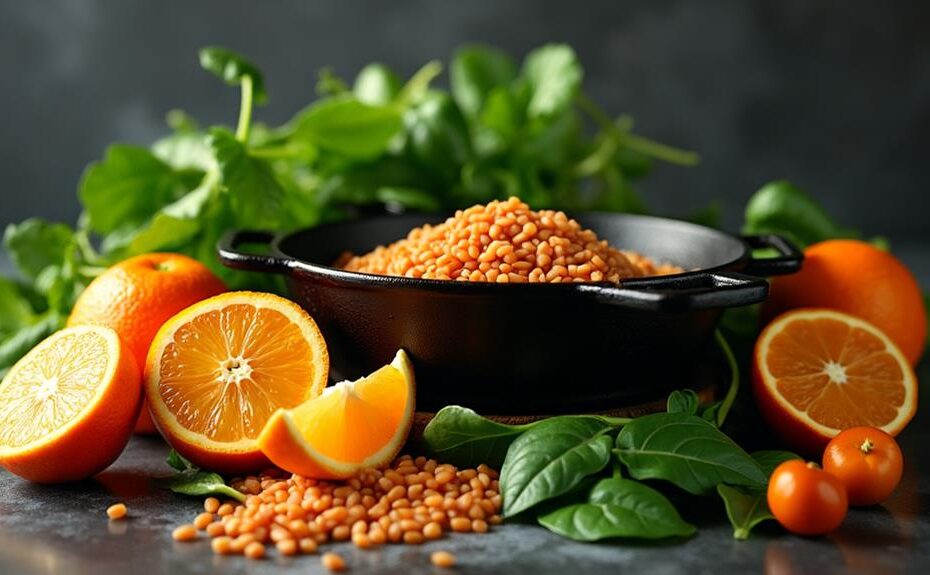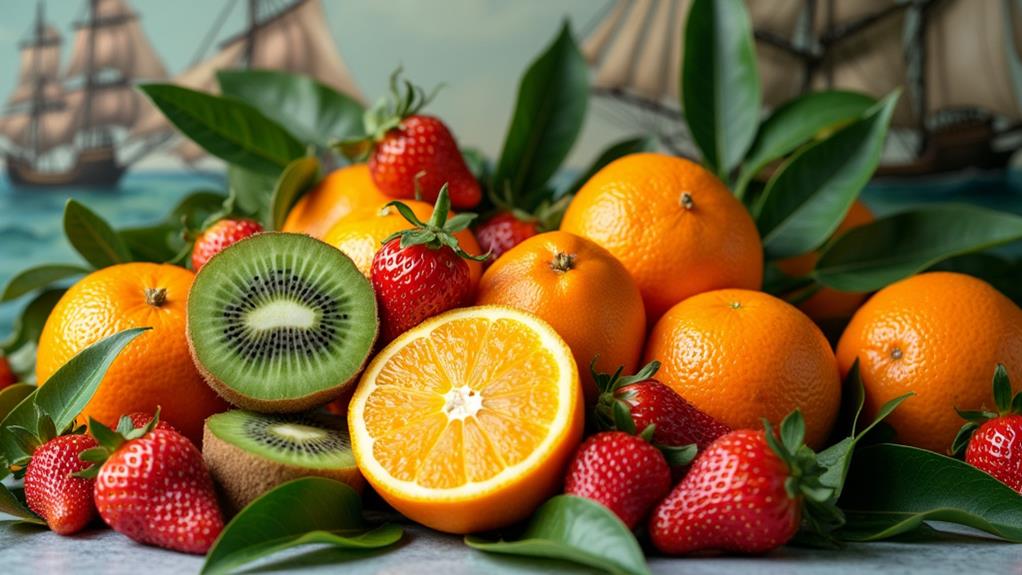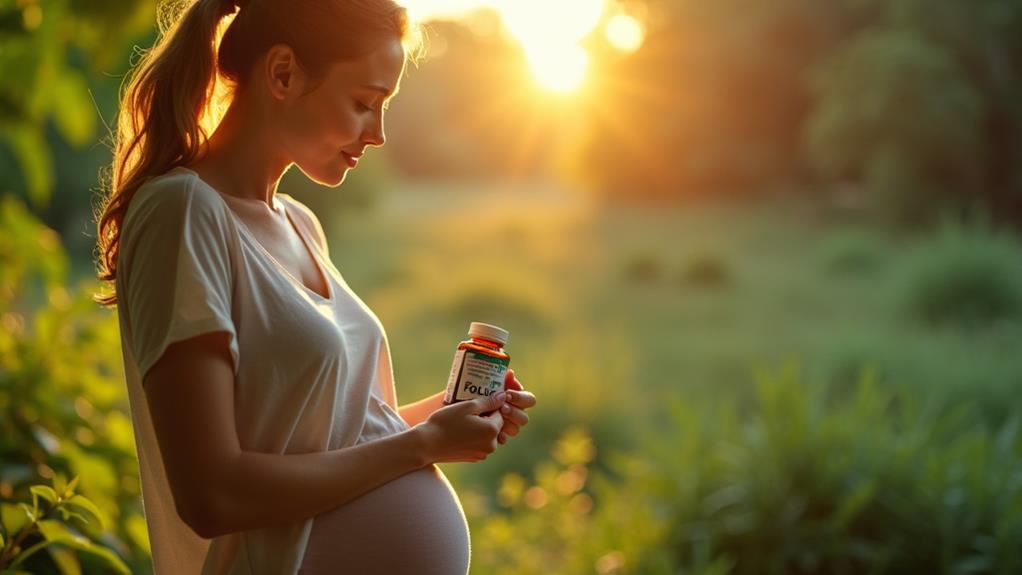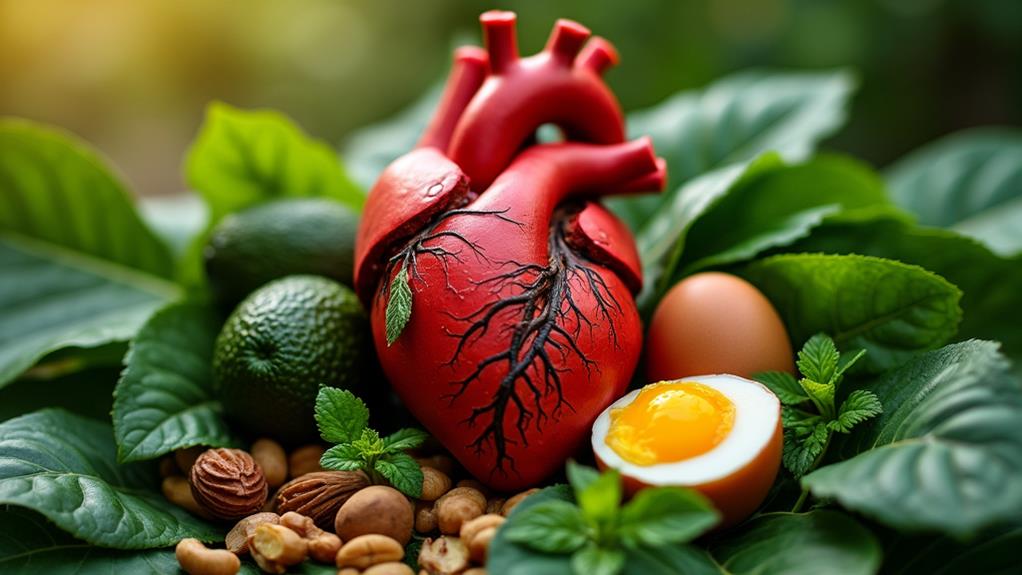
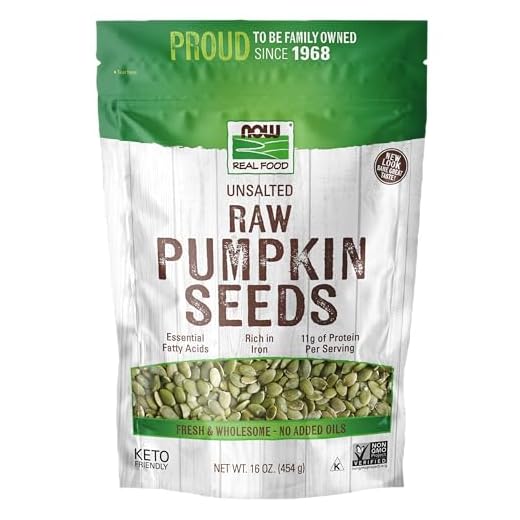






Vitamin C plays an essential role in enhancing your absorption of non-heme iron, which is important, especially if you follow a plant-based diet. It helps keep ferric iron soluble in your intestines, making it easier for your body to absorb. By pairing vitamin C-rich foods, like oranges or bell peppers, with iron sources from plants such as spinach or lentils, you can increase iron absorption markedly—by up to four times! This is particularly beneficial for vegans and vegetarians who may struggle with iron intake. Discover more strategies to optimize your iron levels through diet.
Key Takeaways
- Vitamin C enhances non-heme iron absorption by forming soluble chelates, making iron more absorbable in the intestines.
- It counteracts inhibitors of iron absorption, such as phytates and tannins, thereby improving bioavailability.
- Higher dietary vitamin C intake can increase non-heme iron absorption up to four times when paired with iron-rich foods.
- Vitamin C is particularly important for vegans and vegetarians who rely on non-heme iron sources, helping prevent deficiency.
- Consuming vitamin C-rich foods alongside non-heme iron sources significantly boosts overall iron intake and health outcomes.
Understanding Iron Types
When it comes to understanding iron types, it's critical to break down the differences between heme and non-heme iron. Heme iron, found in animal products, boasts an absorption rate of approximately 15-35%. In contrast, non-heme iron, primarily sourced from plant foods, has a lower absorption rate of only 2-20%. This distinction is essential, especially if you're concerned about iron deficiency anemia. Vitamin C benefits play a notable role in enhancing iron absorption, making it important to examine how these nutrients work together.
The body absorbs iron mainly in the duodenum, where the form of iron greatly impacts its bioavailability. Heme iron is readily absorbed, while non-heme iron faces challenges due to its lower absorption efficiency. Factors like phytates, polyphenols, and calcium can inhibit non-heme iron absorption. However, vitamin C plays a transformative role here; it enhances the absorption of non-heme iron by converting ferric iron (Fe3+) into the more soluble ferrous iron (Fe2+) form. This conversion is crucial, as it makes non-heme iron easier for your body to absorb.
Understanding these differences between heme and non-heme iron can help you make informed dietary choices, ensuring you get the iron you need for ideal health.
Vitamin C's Mechanism of Action
Vitamin C plays an essential role in enhancing the absorption of non-heme iron, primarily by forming a chelate with ferric iron. This chelation process keeps iron soluble and more readily absorbable in your intestines, greatly improving iron absorption efficiency. When you consume vitamin C, often in the form of ascorbic acid, it can counteract the negative effects of dietary components that inhibit iron absorption, such as tannins found in tea and calcium or phosphate from various foods.
Studies demonstrate that the enhancement of non-heme iron absorption is proportional to the amount of vitamin C you consume. This means that higher intakes of ascorbic acid can lead to considerable improvements in your body's ability to absorb this type of iron. Since non-heme iron, which is primarily derived from plant sources, is absorbed less efficiently than heme iron from animal products, vitamin C's role becomes vital in your diet. However, it is essential to keep in mind that vitamin C has minimal effects on insoluble iron compounds, and its benefits are mainly observed with the soluble forms of iron present in plant-based foods.
Importance for Vegans and Vegetarians
For vegans and vegetarians, understanding the role of vitamin C in iron absorption is particularly important. Since you primarily rely on non-heme iron sources, which are less efficiently absorbed than heme iron from animal products, you face a higher risk of iron deficiency. This makes careful dietary planning crucial to meet your iron needs. Incorporating vitamin C-rich foods, like citrus fruits, bell peppers, and strawberries, alongside non-heme iron sources such as lentils, spinach, and chickpeas can greatly enhance your iron absorption. Additionally, supplements like Nature's Bounty Vitamin C + Rose Hips can provide a convenient way to boost your vitamin C intake. Studies show that the effectiveness of non-heme iron absorption can increase by up to four times when consumed with adequate amounts of vitamin C.
To improve your overall iron bioavailability, always pair iron-rich foods with vitamin C sources in your meals. For example, adding lemon juice to your spinach salad or enjoying a smoothie with kale and orange can make a substantial difference. By focusing on these combinations, you can help mitigate the risks associated with a vegetarian diet and guarantee you're getting enough iron to support your overall health.
Anemia Management Strategies
Managing anemia effectively requires a multifaceted approach, particularly when it comes to dietary choices. You should focus on incorporating iron-rich foods into your meals, especially non-heme iron sources like beans, lentils, and leafy greens. Pairing these foods with vitamin C can greatly enhance iron absorption, making it easier for your body to generate red blood cells. This synergy is especially beneficial for individuals with how vitamin C aids absorption of non-heme iron, as it converts iron into a more absorbable form. Foods rich in vitamin C, such as citrus fruits and bell peppers, should be included in your diet to maximize this effect.
If you're dealing with iron deficiency anemia, healthcare providers may recommend iron supplements along with vitamin C to boost your iron levels more effectively. However, recent studies indicate that iron alone may be just as effective for some individuals. Regular monitoring of your iron levels through blood tests is vital; this helps you and your healthcare provider adjust your dietary and supplemental intake as needed.
Be cautious with absorption inhibitors like coffee and tea. Avoid these beverages during meals, as they can hinder the absorption of non-heme iron, making your dietary choices even more important for effective anemia management.
Enhancing Iron Intake Through Diet
A well-planned diet can greatly enhance your iron intake, especially when focusing on non-heme iron sources found in plant foods. Non-heme iron is abundant in foods like lentils, spinach, and beans, but its absorption can be tricky. To improve iron absorption, pair these iron-rich foods with vitamin C-rich options like citrus fruits, bell peppers, or strawberries. This combination considerably boosts the bioavailability of iron, helping you prevent iron deficiency anemia.
For adults, the recommended daily allowance of vitamin C is about 90 mg for men and 75 mg for women. You can easily meet this requirement through a balanced diet filled with fruits and vegetables. For instance, adding lemon juice to a spinach salad not only enhances flavor but also maximizes iron uptake.
It's also essential to avoid inhibitors of non-heme iron absorption. Steer clear of tea, coffee, and calcium-rich foods during your iron-rich meals, as these can limit your body's ability to absorb iron effectively. By making these dietary adjustments, you can enhance absorption and guarantee your body gets the iron it needs for peak health.
Impacts of Iron Deficiency
Iron deficiency can have considerable impacts on your health and well-being. It's the most common nutritional deficiency globally, affecting over 2 billion people, especially women of reproductive age, pregnant women, and young children. If you're among the 10% of women of childbearing age in the U.S. experiencing iron deficiency, it's essential to pay attention. Symptoms like fatigue, weakness, pale skin, and shortness of breath can indicate iron-deficiency anemia (IDA), which greatly affects your energy levels and overall health.
When your dietary iron intake is low, your body absorbs less nonheme iron, leading to decreased metabolic capacity and impaired immune function. This makes you more susceptible to infections and illnesses. To combat iron deficiency, consider how vitamin C helps enhance the absorption of nonheme iron from plant-based sources. Regularly consuming foods rich in both iron and vitamin C can improve your iron levels and help meet the recommended daily intake. Early detection and management of iron deficiency are critical to avoid severe anemia and its associated complications. Staying informed and proactive about your iron intake can lead to better health outcomes.
Research on Vitamin C and Iron
The connection between vitamin C and iron absorption has been a focal point of research in nutrition science. Studies show that vitamin C greatly enhances the absorption of non-heme iron, which is essential for individuals on plant-based diets that primarily rely on this less efficiently absorbed iron type. By forming soluble chelates, vitamin C helps counteract inhibitors like tannins and phytates found in many plant foods.
Research indicates that the enhancement of non-heme iron absorption by vitamin C is dose-dependent; higher amounts of vitamin C lead to greater improvements in iron bioavailability. Pairing foods high in vitamin C, such as citrus fruits, with non-heme iron sources like legumes and dark leafy greens can notably improve your overall iron absorption.
Interestingly, a randomized clinical trial revealed no notable difference in hemoglobin levels between patients receiving iron supplements alone and those receiving iron with vitamin C. This suggests that while vitamin C aids absorption, iron supplementation alone can still be effective in treating iron deficiency. Understanding these dynamics can help you make informed dietary choices to enhance your iron intake and overall health.
Meal Pairing Techniques
When you combine vitamin C-rich foods with non-heme iron sources, you greatly boost your iron absorption. This powerful pairing markedly enhances the bioavailability of non-heme iron found in plant sources, increasing absorption by up to 67%. To make the most of your meals, consider incorporating foods like citrus fruits or bell peppers alongside iron-rich options such as beans or spinach.
Breakfast is an excellent opportunity for meal pairing. You could add strawberries to your oatmeal or enjoy a glass of orange juice with fortified cereal, which can provide up to 100% of your daily iron requirement. This combination not only enhances absorption but also contributes to a balanced start to your day.
While you're focusing on meal pairing, be mindful of what you drink. Coffee and tea can inhibit non-heme iron absorption, so it's best to avoid them during meals. Instead, prioritize vitamin C sources to counteract this effect and optimize your iron intake. By strategically combining these foods, you can effectively enhance absorption without needing to rely solely on iron supplements.
Future Directions in Nutritional Research
As you consider the impact of meal pairing on nutrient absorption, it's important to look ahead at the future directions in nutritional research. Researchers are focusing on cost-effective strategies to enhance iron bioavailability, particularly for at-risk populations like vegetarians and pregnant women. This includes examining the stability of vitamin C during food storage to guarantee it effectively boosts iron absorption in various dietary contexts.
Additionally, studies are underway to assess the long-term effects of combining vitamin C with iron supplements on overall iron status and anemia management across diverse groups. There's also a growing interest in exploring alternative iron sources, such as plant-based supplements and fortified foods, to optimize dietary recommendations.
Understanding the impact of dietary patterns and meal composition on iron absorption remains vital. Researchers are investigating how meal timing and food combinations can further enhance iron bioavailability. By focusing on these areas, future research aims to provide clearer guidelines for managing iron deficiency and improving health outcomes, ensuring that dietary recommendations are both practical and effective.
Conclusion
Incorporating vitamin C into your diet is like adding fuel to a fire, igniting your body's ability to absorb iron effectively. By understanding how these nutrients work together, especially for vegans and vegetarians, you can enhance your health and prevent iron deficiency. Emphasizing vitamin C-rich foods alongside iron sources not only supports anemia management but also promotes overall well-being. As research evolves, staying informed will empower you to make better dietary choices for a vibrant life.
